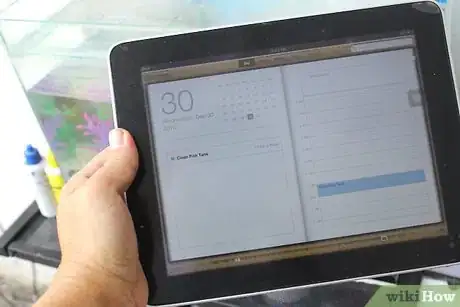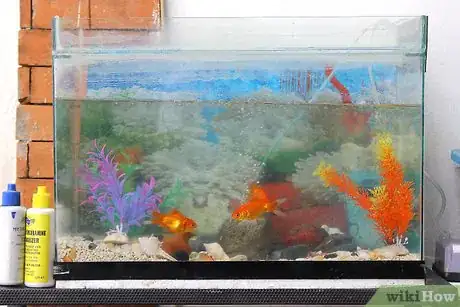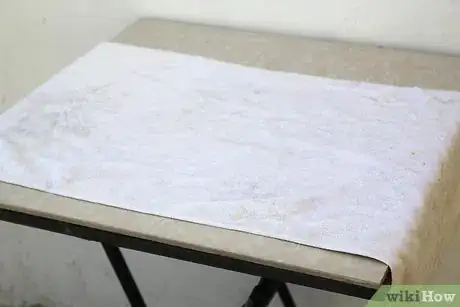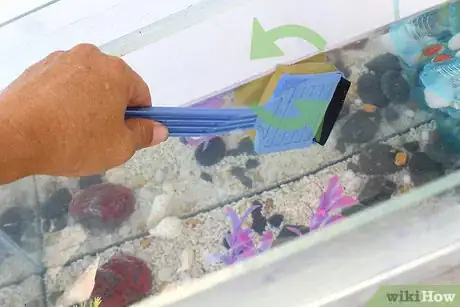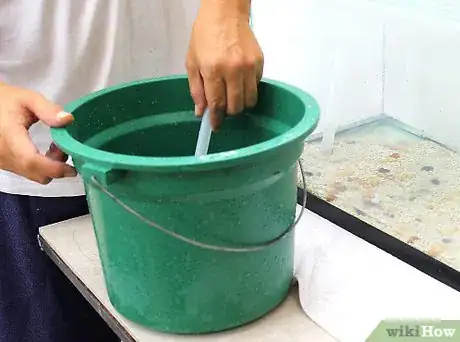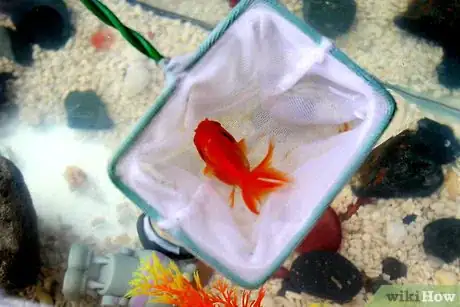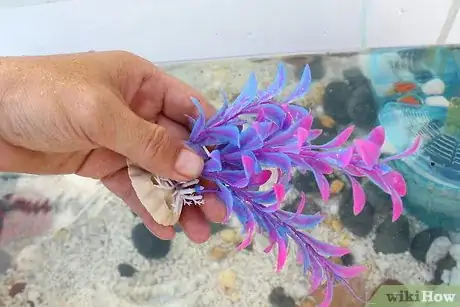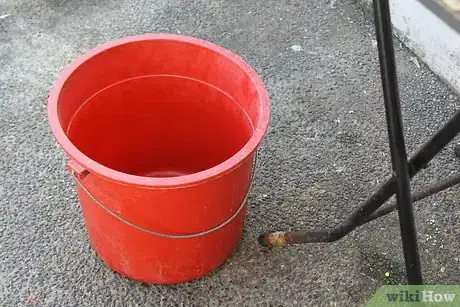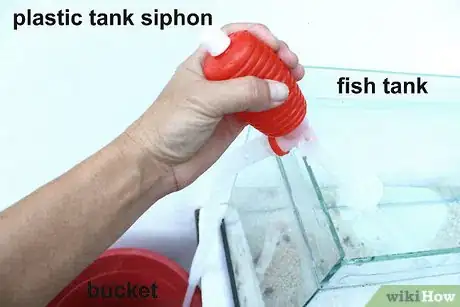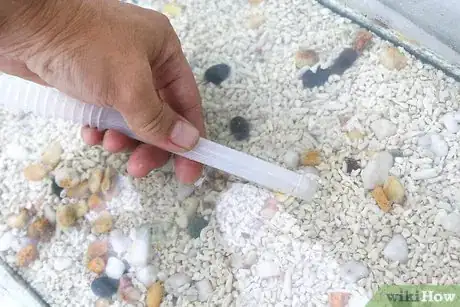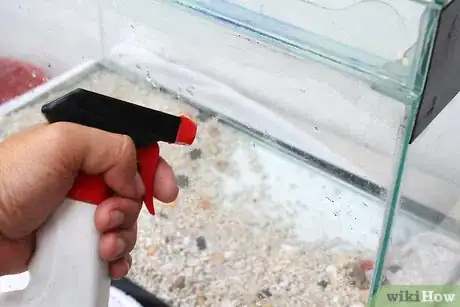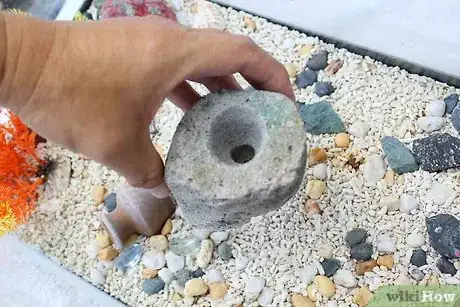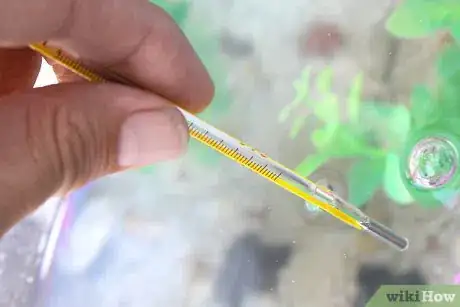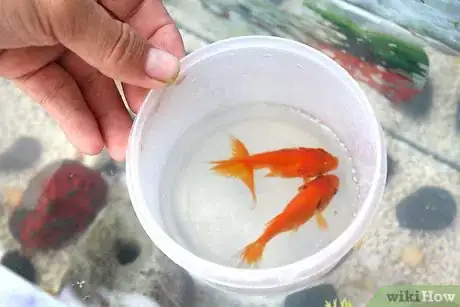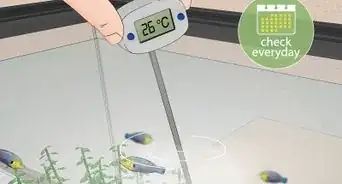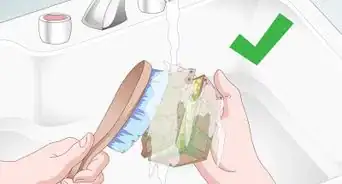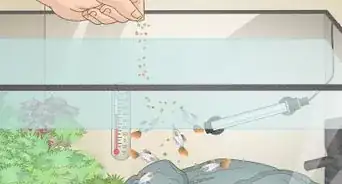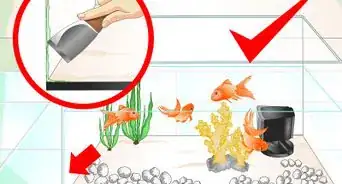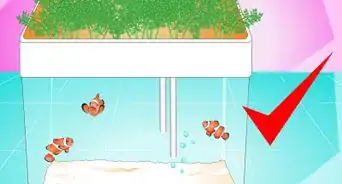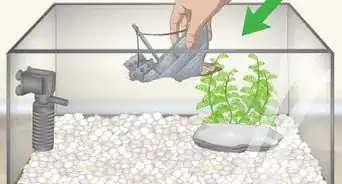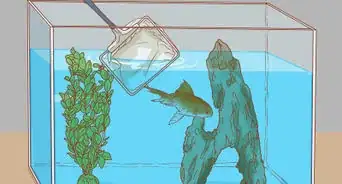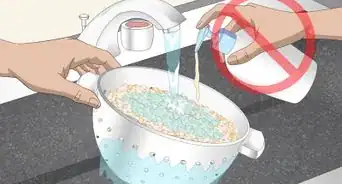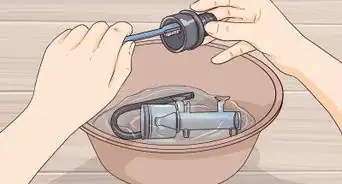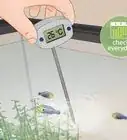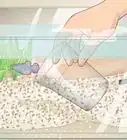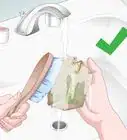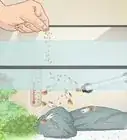This article was co-authored by Marshall Stephens. Marshall Stephens is an Aquarium Expert at Private Oceans Aquariums in West Palm Beach, Florida. Marshall has over 20 years of experience in the aquarium industry and focuses on captive-bred animals. They specialize in tropical and marine aquariums and are a contributor to the Loggerhead Marine life center in Jupiter Florida.
There are 11 references cited in this article, which can be found at the bottom of the page.
This article has been viewed 134,881 times.
Is your small freshwater fish tank dirty? Small fish tanks hold under 10 gallons (39 liters) of water. Because small fish tanks often lack filtration, they require more frequent upkeep than large fish tanks.[1] To clean your small fish tank, remove the fish, clean the tank and decorations, and add treated, fresh water. Deep cleaning your fish tank every other week is an important way to keep your fish happy and healthy.
Steps
Preparing to Clean Your Fish Tank
-
1Schedule time to clean your tank. With small fish tanks, you must do fifty percent or larger water changes at least twice weekly but preferably every other day. Without massive, frequent water changes, the tank can destabilize and put your fish at risk. Thus, it is important to schedule time to do your fish tank water changes and cleaning.[2] Every other week, perform deep cleanings in which you remove decorations and scrub the interior.
- Observe your fish daily to see whether they look healthy and are behaving normally. Do they have good color, clean scales, unclamped fins? Or are they slimy and ragged? Remove any dead fish. If your fish look sluggish, stressed, or they are gulping for air, do a water change.[3]
- It is not beneficial to perform deep cleanings too often, as you will remove essential bacteria.
-
2Gather cleaning supplies. Make a checklist to ensure that you have all the necessary supplies. Having your supplies on hand will speed up the process. Most supplies are available at pet or home goods stores. Use this list to help you.
- 2 fish nets
- Temporary fish tank or container
- Fresh water in the quantity you want to replace
- Algae pad
- New toothbrush
- 2 large buckets (5-10 gallons)
- Gravel vacuum
- Siphon
- Water conditioner
- Aquarium-safe glass cleaner or a vinegar-based solution
- Clean cloth
- Towel
Advertisement -
3Prepare your work space. Place tarps or towels on the floor to catch any spilled water. Keep the tank in place. Do not move your tank or tip it into the sink. Juggling your fish puts them under stress and stirs debris in the tank.
-
4Dress appropriately. Wear a short-sleeved shirt or tank top. You might consider wearing a bathing suit. Aprons also can protect your clothing. Wearing water-resistant shoes like water shoes or flip flops is also a good idea.
-
5Unplug electrical devices. If applicable, unplug the aquarium’s aerator, filter, and heater. Leave hood lights plugged in. Place the hood behind the tank to illuminate the tank.[4]
Cleaning the Tank
-
1Scrub the sides of the tank. It is important to clean the glass before removing any water. Use an aquarium sponge or clean soap-free cloth to remove algae and grime. Some fish owners leave algae, as it is preferable to green water and provides food for many fish. Still, it is best to remove some algae.[5]
-
2Fill your temporary fish tank or container with some original fish tank water. By using the current tank water, you will cause less environmental stress on the fish.[6] Make sure your temporary container is clean and has no soapy residue. If you are unsure of its cleanliness status, clean it with an aquarium-safe glass cleaner or a vinegar-based solution.
-
3Remove fish or aquatic creatures from your tank with a fish net. Be gentle and mindful. You may want to use two nets. Use one net to herd the fish into the other net. Put your fish in the temporary container with the original tank water. Never put them in tap water. Do not allow the fish to jump from the temporary tank. Put a cover on the tank.[7]
-
4Remove decorative items (plants, rocks, etc.). While you do not need to remove decorative items for every water change, remove them for cleanings. Put them on a towel, and rinse them with clean, room temperature water. You may use an algae pad or new toothbrush as well. Do not use detergent or soap to wash them. The fish will die from the toxicity of soap. If algae overwhelms your decorations, consider changing your feeding or maintenance routines.
-
5Set up your five to ten gallon bucket. Place the bucket for catching the old water below the level of the fish tank. If possible, set the bucket on the floor or on a chair. Stability is important as is close proximity to the tank. It is best to buy a new bucket to use only for cleaning your fish tank. Residue from soaps or detergents can harm your fish.
-
6Siphon out the old water. Remove twenty-five percent of the water at a time.[8] An appropriate siphon is a small 3/8" hose that is four to five feet long. Slowly lower the complete siphon into the aquarium. Ensure that all the air is out of the tube. Plug one end of the tube with your finger and lift that end from the tank. Keep the other end in the water. Lower the removed end towards the bucket while keeping your finger in place. When you remove your finger, the water should flow into the bucket.[9] Slowly transfer the old water into the bucket.
- You can purchase a plastic tank siphon at pet shops. You also can purchase a small hand pump to put on the siphon to assist with the water transfer.
- Your fish are used to their old water. Removing all of it can be a shock to their organs. When you mix new water with the old water, your fish will be healthier.
-
7Vacuum debris from gravel. While you siphon water into the bucket, vacuum the gravel with the water siphon to remove fish waste and leftover food. Aquarium gravel vacuums are rigid, plastic tubes, two inches in diameter that attach to the siphon.[10] Gravel vacuums use the momentum of the water flowing through the siphon to loosen debris and remove solid waste from your tank.[11]
- It is crucial for a small tank to have good beneficial bacteria. Using gravel helps bacteria grow.
-
8Clean the exterior of the tank. Wipe down the outside of the tank. Use a vinegar-based solution or buy an aquarium-safe cleaner. Dry the exterior with a clean towel. Consider using an unbleached organic paper towel.
Reintroducing Tank Components
-
1Return decorations. After you finish cleaning your tank, return the decorations. Add gravel if necessary. Also, add any new decorations at this time.
-
2Treat water with conditioner. Prior to filling your tank with new water, treat tap water with a water conditioner. Try to find a conditioner that neutralizes chlorine, chloramine, ammonia, and other chemicals.[12] Dechlorinators are essential.[13] Be sure to condition the water in a clean bucket before adding it to the tank.[14]
-
3Replace the removed water with fresh, treated water. Use a thermometer to verify the temperature of the new water matches the temperature of the old water. Having a consistent temperature for your fish is important for their health.[15] Use your siphon to put the new water into the tank. Place your bucket at a height higher than the tank and slowly introduce the new water. Do not fill the aquarium too high. There needs to be space between the water’s surface and the aquarium cover because your fish rely on oxygen exchange at the water’s surface to breathe.[16]
-
4Acclimate the fish to the new environment. Place them in a cup. Float the cup within the tank before releasing them. This process ensures the fish can adjust to the tank’s water temperature and not go into shock when released. Release your fish into the tank.
- An alternative is to place the fish into small plastic airtight bags half filled with old tank water upon removing them from the tank. When you are ready to reintroduce the fish, float the bags in the tank for fifteen to twenty minutes. This will ensure that the water temperature is the same in both the bag and the tank. After this time, open the bags.
Expert Q&A
-
QuestionHow do I get rid of little snails in my aquarium?
 Marshall StephensMarshall Stephens is an Aquarium Expert at Private Oceans Aquariums in West Palm Beach, Florida. Marshall has over 20 years of experience in the aquarium industry and focuses on captive-bred animals. They specialize in tropical and marine aquariums and are a contributor to the Loggerhead Marine life center in Jupiter Florida.
Marshall StephensMarshall Stephens is an Aquarium Expert at Private Oceans Aquariums in West Palm Beach, Florida. Marshall has over 20 years of experience in the aquarium industry and focuses on captive-bred animals. They specialize in tropical and marine aquariums and are a contributor to the Loggerhead Marine life center in Jupiter Florida.
Aquarium Specialist Snail traps are a good solution! You can also introduce assassin snails into your tank (snails that eat other snails), or introduce other fish that eat snails. You can also use copper sulfate—just be careful if you have a lot of snails in your tank, since killing them all at once can lower the water quality. To prevent snails in the first place, inspect your plants before sticking them in your aquarium.
Snail traps are a good solution! You can also introduce assassin snails into your tank (snails that eat other snails), or introduce other fish that eat snails. You can also use copper sulfate—just be careful if you have a lot of snails in your tank, since killing them all at once can lower the water quality. To prevent snails in the first place, inspect your plants before sticking them in your aquarium. -
QuestionWhy are larger fish tanks easier to maintain?
 Marshall StephensMarshall Stephens is an Aquarium Expert at Private Oceans Aquariums in West Palm Beach, Florida. Marshall has over 20 years of experience in the aquarium industry and focuses on captive-bred animals. They specialize in tropical and marine aquariums and are a contributor to the Loggerhead Marine life center in Jupiter Florida.
Marshall StephensMarshall Stephens is an Aquarium Expert at Private Oceans Aquariums in West Palm Beach, Florida. Marshall has over 20 years of experience in the aquarium industry and focuses on captive-bred animals. They specialize in tropical and marine aquariums and are a contributor to the Loggerhead Marine life center in Jupiter Florida.
Aquarium Specialist There's not as much of a variety of filtration to choose from for a small fish tank. Also, larger fish tanks give you a wider margin of error to catch a potential problem and fix it, while things can change quickly in a small tank due to the small volume of water.
There's not as much of a variety of filtration to choose from for a small fish tank. Also, larger fish tanks give you a wider margin of error to catch a potential problem and fix it, while things can change quickly in a small tank due to the small volume of water.
Warnings
- This tutorial is only for freshwater fish tanks and freshwater fish.⧼thumbs_response⧽
References
- ↑ http://www.firsttankguide.net/fish-bowl-maintenance.php
- ↑ http://www.firsttankguide.net/fish-bowl-maintenance.php
- ↑ http://pets.thenest.com/should-clean-out-freshwater-aquarium-tank-12316.html
- ↑ http://www.instructables.com/id/Dirty-Tank-Lets-Clean-It-Up/
- ↑ http://www.firsttankguide.net/waterchange.php
- ↑ http://www.instructables.com/id/Dirty-Tank-Lets-Clean-It-Up/
- ↑ http://www.instructables.com/id/Dirty-Tank-Lets-Clean-It-Up/
- ↑ http://www.firsttankguide.net/fish-bowl-maintenance.php
- ↑ http://www.firsttankguide.net/siphon-start.php
- ↑ http://www.firsttankguide.net/vacuuming-aquarium.php
- ↑ http://www.firsttankguide.net/gravel-vacuum.php
- ↑ http://aquariumfish.net/information/water_conditioner.htm
- ↑ http://www.firsttankguide.net/water-conditioner.php
- ↑ http://www.fishchannel.com/fish-health/healthy-aquariums/water-conditioners.aspx
- ↑ http://www.firsttankguide.net/waterchange.php
- ↑ http://www.firsttankguide.net/waterchange.php
- ↑ http://www.howtocleanstuff.net/how-to-clean-an-aquarium-filter/
About This Article
To clean a small fish tank, start by unplugging the aquarium’s aerator, filter, and heater. Next, use a sponge or cloth to remove algae and grime from the sides of the tank before draining the water. Then, transfer your fish to a temporary container and remove all decorative items from the tank. Siphon out 50% of the old water into a 5-10 gallon bucket with a hose and vacuum the gravel. Finally, wipe down the outside of the tank with a vinegar-based solution. For tips on putting everything back into the cleaned tank and adding fresh water, read on!
